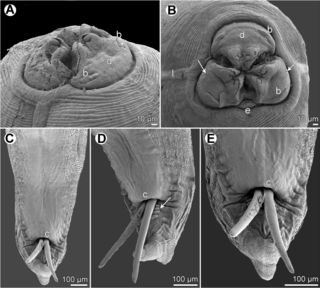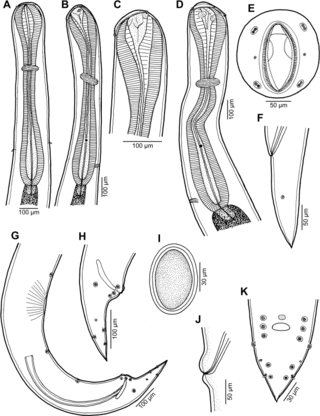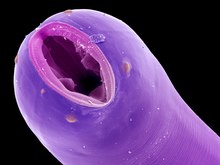
Paracapillaria is a genus of parasitic nematodes. Species of the genus Paracapillaria parasitise fishes and amphibians, reptiles (snakes), and a single species, Paracapillaria philippinensis(Chitwood, Velasquez & Salazar, 1968), is known from birds and mammals including man.

Philometra is a genus of nematodes, which are parasites of marine and freshwater fishes. The genus was erected by Oronzio Gabriele Costa in 1845.
Philometra priacanthi is a species of parasitic nematode of fishes. Its name is derived from its host species, Priacanthus hamrur. It possesses dorsal lamella-like structures on the distal part of its gubernaculum, which can also be found on other of its cogenerates. The only species with a dorsal protuberance near the gubernaculum's end is P. priacanthi, however. P. lateolabracis can be distinguished from the former by the lateral caudal mounds separated dorsally, narrower lamella-like structures on its gubernaculum, shorter spicules, and by the testis extending anteriorly. Other gonad-infecting species differ from this one by possessing a smooth gubernaculum, and their spicules being of different lengths. Seven gonad-infecting species of Philometra can be distinguished from P. priacanthi by their host types, as well as by geographical distribution.

Philometra fasciati is a species of parasitic nematode of fishes, first found off New Caledonia in the South Pacific, in the gonads Epinephelus fasciatus. This species is characterized mainly by: length of spicules and length and structure of its gubernaculum; structure of male caudal end; body size; location in host and types of hosts.

Cucullanus bulbosus is a species of parasitic nematodes. It is an endoparasite of carangid fishes.

Rasheedia is a genus of nematodes in the order Spirurida. The nematode genus BulbocephalusRasheed, 1966 was found to be a homonym of BulbocephalusWatson, 1916 and, therefore, a new name, Rasheedia n. nom., was proposed in 2018 to substitute it.

Cucullanus austropacificus is a species of parasitic nematodes. It is an endoparasite of the fish Conger cinereus. The species has been described in 2018 by František Moravec & Jean-Lou Justine from material collected off New Caledonia in the South Pacific Ocean.

Cucullanus gymnothoracis is a species of parasitic nematodes. It is an endoparasite of the lipspot moray Gymnothorax chilospilus. The species has been described in 2018 by František Moravec & Jean-Lou Justine from material collected off New Caledonia in the South Pacific Ocean.

Cucullanus incognitus is a species of parasitic nematodes. It is an endoparasite of the rare sparid fish Dentex fourmanoiri. The species has been described in 2018 by František Moravec & Jean-Lou Justine from material collected off New Caledonia in the South Pacific Ocean. Only female specimens were found.

Cucullanus epinepheli is a species of parasitic nematodes. It is an endoparasite of the brown spotted reef cod Epinephelus chlorostigma. The species has been described in 2018 by František Moravec & Jean-Lou Justine from material collected off New Caledonia in the South Pacific Ocean.

Cystidicolidae is a family of spirurian nematodes. It was described by Skrjabin in 1946. All members of the family are parasites of fish.

Ascarophis is a genus of parasitic nematodes, belonging to the family Cystidicolidae. Species of Ascarophis are parasitic as adults in the gastrointestinal tract of marine and estuarine fishes.

Ascarophisnema is a genus of parasitic nematodes, belonging to the family Cystidicolidae. Species of Ascarophisnema are parasitic as adults in the gastrointestinal tract of fish. According to the World Register of Marine Species, the genus currently (2019) includes a single species, Ascarophisnema tridentatum.

Neoterranova is a genus of parasitic nematodes that have life cycles involving sharks and reptiles. The genus was created in 2020 to accommodate species which were previously included inTerranovaLeiper & Atkinson, 1914 a taxon considered to be invalid.

Cucullanus variolae is a species of parasitic nematodes. It is an endoparasite of the fish species Variola louti (type-host) and Variola albimarginata. The species has been described in 2020 by František Moravec & Jean-Lou Justine from material collected off New Caledonia in the South Pacific Ocean.

Cucullanus acutospiculatus is a species of parasitic nematodes. It is an endoparasite of a fish, the redbelly yellowtail fusilier, Caesio cuning. The species has been described in 2020 by František Moravec & Jean-Lou Justine from material collected off New Caledonia in the South Pacific Ocean.

Cucullanus diagrammae is a species of parasitic nematodes. It is an endoparasite of a fish, the Painted sweetlips Diagramma pictum. The species has been described in 2020 by František Moravec & Jean-Lou Justine from material collected off New Caledonia in the South Pacific Ocean.

Cucullanus parapercidis is a species of parasitic nematodes. It is an endoparasite of fish, the Yellowbar sandperch Parapercis xanthozona, which is the type-host, and the Speckled sandperch Parapercis hexophtalma. The species has been described in 2020 by František Moravec & Jean-Lou Justine from material collected off New Caledonia in the South Pacific Ocean.

Cucullanus petterae is a species of parasitic nematodes. It is an endoparasite of fish, the Honeycomb grouper Epinephelus merra, which is the type-host, and the Blacktip grouper Epinephelus fasciatus. The species has been described in 2020 by František Moravec & Jean-Lou Justine from material collected off New Caledonia in the South Pacific Ocean.

Ichthyofilaroides is a genus of parasitic nematodes, belonging to the family Guyanemidae Petter, 1974.



















